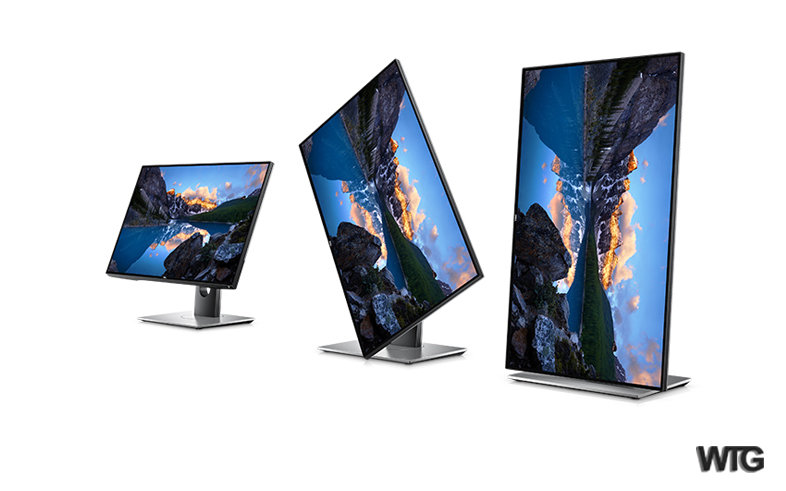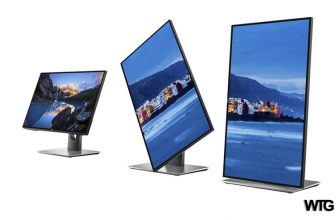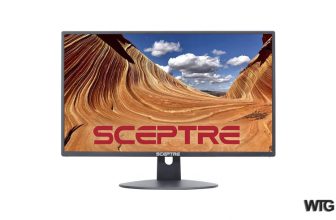
A computer monitor is an output device that displays information in pictorial form. A monitor usually comprises the visual display, circuitry, casing, and power supply. The display device in modern monitors is typically a thin film transistor liquid crystal display (TFT-LCD) with LED backlighting having replaced cold-cathode fluorescent lamp (CCFL) backlighting. Previous monitors used a cathode ray tube (CRT). Monitors are connected to the computer via VGA, Digital Visual Interface (DVI), HDMI, DisplayPort, USB-C, low-voltage differential signaling (LVDS) or other proprietary connectors and signals.
Originally, computer monitors were used for data processing while television sets were used for entertainment. From the 1980s onwards, computers (and their monitors) have been used for both data processing and entertainment, while televisions have implemented some computer functionality. The common aspect ratio of televisions, and computer monitors, has changed from 4:3 to 16:10, to 16:9.
Modern computer monitors are easily interchangeable with conventional television sets and vice versa. However, as computer monitors do not necessarily include integrated speakers nor TV tuners (such as Digital television adapters), it may not be possible to use a computer monitor as a TV set without external components.
History
Early electronic computers were fitted with a panel of light bulbs where the state of each particular bulb would indicate the on/off state of a particular register bit inside the computer. This allowed the engineers operating the computer to monitor the internal state of the machine, so this panel of lights came to be known as the ‘monitor’. As early monitors were only capable of displaying a very limited amount of information and were very transient, they were rarely considered for program output. Instead, a line printer was the primary output device, while the monitor was limited to keeping track of the program’s operation.
Computer monitors were formerly known as visual display units (VDU), but this term had mostly fallen out of use by the 1990s.
Cathode ray tube
The first computer monitors used cathode ray tubes (CRTs). Prior to the advent of home computers in the late 1970s, it was common for a video display terminal (VDT) using a CRT to be physically integrated with a keyboard and other components of the system in a single large chassis. The display was monochrome and far less sharp and detailed than on a modern flat-panel monitor, necessitating the use of relatively large text and severely limiting the amount of information that could be displayed at one time. High-resolution CRT displays were developed for the specialized military, industrial and scientific applications but they were far too costly for general use.
Some of the earliest home computers (such as the TRS-80 and Commodore PET) were limited to monochrome CRT displays, but color display capability was already a standard feature of the pioneering Apple II, introduced in 1977, and the speciality of the more graphically sophisticated Atari 800, introduced in 1979. Either computer could be connected to the antenna terminals of an ordinary color TV set or used with a purpose-made CRT color monitor for optimum resolution and color quality. Lagging several years behind, in 1981 IBM introduced the Color Graphics Adapter, which could display four colors with a resolution of 320 × 200 pixels, or it could produce 640 × 200 pixels with two colors. In 1984 IBM introduced the Enhanced Graphics Adapter which was capable of producing 16 colors and had a resolution of 640 × 350.
By the end of the 1980s color CRT monitors that could clearly display 1024 × 768 pixels were widely available and increasingly affordable. During the following decade, maximum display resolutions gradually increased and prices continued to fall. CRT technology remained dominant in the PC monitor market into the new millennium partly because it was cheaper to produce and offered to view angles close to 180°. CRTs still offer some image quality advantages over LCDs but improvements to the latter have made them much less obvious. The dynamic range of early LCD panels was very poor, and although text and other motionless graphics were sharper than on a CRT, an LCD characteristic known as pixel lag caused moving graphics to appear noticeably smeared and blurry.
Liquid Crystal Display (LCD)
There are multiple technologies that have been used to implement liquid crystal displays (LCD). Throughout the 1990s, the primary use of LCD technology as computer monitors was in laptops where the lower power consumption, lighter weight, and smaller physical size of LCDs justified the higher price versus a CRT. Commonly, the same laptop would be offered with an assortment of display options at increasing price points: (active or passive) monochrome, passive color, or active matrix color (TFT). As volume and manufacturing capability have improved, the monochrome and passive color technologies were dropped from most product lines.
TFT-LCD is a variant of LCD which is now the dominant technology used for computer monitors.
The first standalone LCDs appeared in the mid-1990s selling for high prices. As prices declined over a period of years they became more popular, and by 1997 were competing with CRT monitors. Among the first desktop LCD computer monitors was the Eizo FlexScan L66 in the mid-1990s, the Apple Studio Display and the ViewSonic VP140 in 1998. In 2003, TFT-LCDs outsold CRTs for the first time, becoming the primary technology used for computer monitors. The main advantages of LCDs over CRT displays are that LCDs consume less power, take up much less space, and are considerably lighter. The now common active matrix TFT-LCD technology also has less flickering than CRTs, which reduces eye strain. On the other hand, CRT monitors have superior contrast, have a superior response time, are able to use multiple screen resolutions natively, and there is no discernible flicker if the refresh rate is set to a sufficiently high value. LCD monitors have now very high temporal accuracy and can be used for vision research.
High dynamic range (HDR) has been implemented into high-end LCD monitors to improve color accuracy. Since around the late 2000s, widescreen LCD monitors have become popular, in part due to television series, motion pictures and video games transitioning to high-definition (HD), which makes standard-width monitors unable to display them correctly as they either stretch or crop HD content. These types of monitors may also display it in the proper width, by filling the extra space at the top and bottom of the image with a solid color (“letterboxing”). Other advantages of widescreen monitors over standard-width monitors is that they make work more productive by displaying more of a user’s documents and images, and allow displaying toolbars with documents. They also have a larger viewing area, with a typical widescreen monitor having a 16:9 aspect ratio, compared to the 4:3 aspect ratio of a typical standard-width monitor.
Organic Light-Emitting Diode (OLED)
Organic light-emitting diode (OLED) monitors provide higher contrast, better color reproduction and viewing angles than LCDs but they require more power when displaying documents with white or bright backgrounds and have a severe problem known as burn-in, just like CRTs. They are less common than LCD monitors and are often more expensive.
Related Articles
- Best Monitor Under 150 Dollars
- Best Monitor Under $300
- Best Monitor Under $500
- 24 inch Monitor Best of 2023
- 27 inch Monitor Best of 2023
- 32 inch Monitor Best of 2023
- Best 27 inch Monitor Under $300
- Best 27 inch Monitor Under $200
- Dell 27 inch Monitor Best of 2023
- Best Vertical Monitor 2023
- Best Bezel Less Monitor 2023
- Best Ultrawide Monitor 2023
- Best Curved Monitor 2023
- Monitor with Speakers Best of 2023
- 2K Monitor Best of 2023
- Best 120Hz Monitor 2023
- Best Monitor for Graphic Design 2023
- Best Budget Monitor for Graphic Design 2023
- Best Monitor for Programming 2023
- Best Monitor for Watching Movies 2023
- LG Monitor Best of 2023
- ViewSonic Monitor Best of 2023
- Best HP Monitor 2023
- BenQ Monitor Best of 2023
- Sceptre Monitor Best of 2023
- Best MSI Monitor 2023
- ASUS Gaming Monitor Best of 2023
- Best Monitor for Color Grading 2021
- Best IPS Monitor Under $200
- Best Monitor for Photo Editing Under $500
- Best Dual Monitor Stand
- Best Triple Monitor Stand






